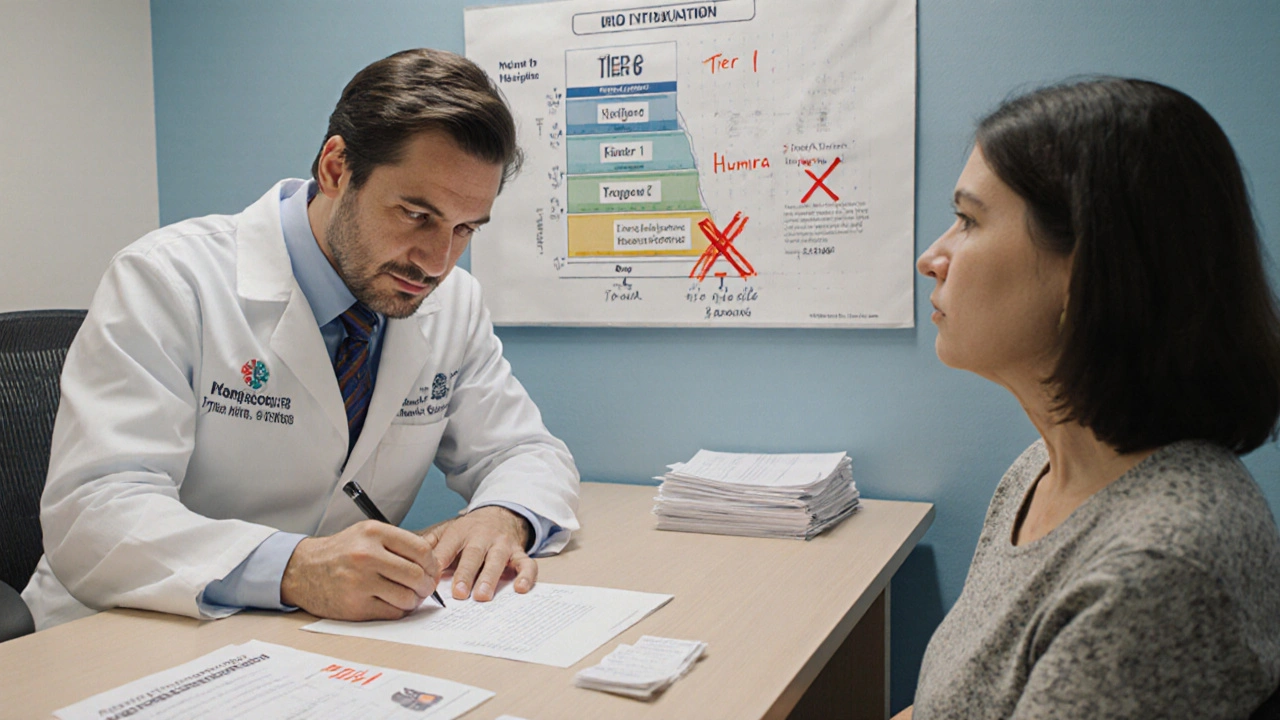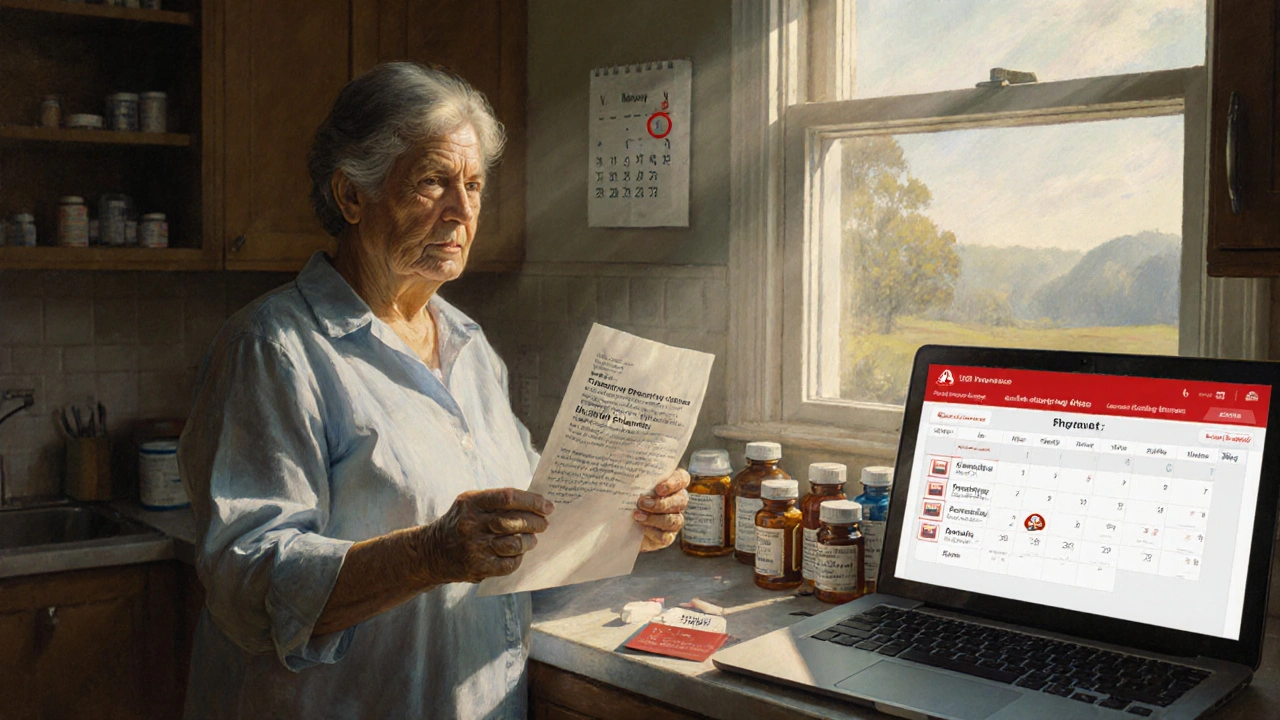When your insurance plan changes which drugs it covers, it can feel like a rug pulled out from under you. You’ve been taking the same medication for years - maybe it’s keeping your diabetes under control, or your arthritis manageable - and then one day, you get a letter saying it’s no longer on the formulary. Or worse, it’s still covered, but now you’re paying $600 a month instead of $50. This isn’t rare. In 2024, 34% of Medicare beneficiaries experienced a formulary change that affected their medication. For people on commercial plans, it’s even more unpredictable.
What Is a Formulary, Really?
A formulary is a list of prescription drugs your insurance plan agrees to pay for. It’s not just a catalog - it’s a tool used to control costs and guide prescribing. Most plans use a tiered system: Tier 1 is usually generic drugs with the lowest copay, Tier 2 is preferred brand-name drugs, Tier 3 is non-preferred brands, and Tier 4 or 5 are specialty drugs like biologics for autoimmune diseases or cancer treatments. Some plans even have a Tier 6 for ultra-expensive therapies. The goal? Keep costs down for the insurer. But the impact? Often, it’s felt most by patients. In 2023, a study found patients forced to switch drugs because of formulary changes paid an average of $587 more per year out of pocket. And for some, that’s not just money - it’s health. When Humira moved from preferred to non-preferred status on one plan, a patient’s monthly cost jumped from $50 to $650. That’s not a tweak - that’s a crisis.Why Do Formularies Change?
Formularies aren’t static. They’re reviewed at least quarterly by Pharmacy and Therapeutics (P&T) committees - teams of doctors, pharmacists, and sometimes patient advocates. These committees look at new drugs, price negotiations, clinical evidence, and rebate deals from manufacturers. If a drug gets a better rebate, the plan might move it to a lower tier. If a cheaper generic becomes available, the brand might get kicked off entirely. Medicare Part D plans must cover at least two drugs per therapeutic class, but they can still exclude others. Commercial plans have even more flexibility. In fact, 87% of all insurance plans use tiered formularies. And while Medicare plans must give you 60 days’ notice before removing a drug, commercial insurers often give as little as 22 days - sometimes just a note on your online portal.What Happens When Your Drug Gets Removed?
If your medication is taken off the formulary, you have options - but you need to act fast.- Request a formulary exception: This is a formal request asking your plan to cover your drug anyway. You’ll need a letter from your doctor explaining why the alternative drugs won’t work for you. In 2023, 64% of medically justified exceptions were approved by Medicare plans. For commercial plans, approval rates vary but are often similar if you have strong clinical documentation.
- Ask for a transition fill: If your drug is being removed, most plans must let you finish your current prescription - and sometimes give you a 30- to 60-day supply of the old drug while you switch. Don’t assume this happens automatically. Call your pharmacy and ask.
- Use manufacturer assistance programs: Many drugmakers offer copay cards or free drug programs for eligible patients. In 2024, these programs covered $6.2 billion in patient costs. For Humira, AbbVie’s program can reduce your cost to $5 a month if you qualify.
- Switch to an alternative: Your doctor might have a similar drug on formulary. But don’t just swap - ask if it’s been studied for your condition. For example, switching from one biologic to another for rheumatoid arthritis isn’t always seamless.

How Providers Can Help
Doctors and pharmacists aren’t just bystanders - they’re your first line of defense. Large medical groups now use e-prescribing systems that check formulary status in real time. When a doctor writes a prescription, the system flags if it’s not covered or if there’s a cheaper alternative. This catches issues before you even get to the pharmacy. One clinic in Minnesota started a proactive monitoring system: they check formulary updates 60 days before they take effect. That means they can switch patients during routine visits - no surprises, no emergency calls. That’s the gold standard. If your provider isn’t doing this, ask them to start.What You Can Do Before It Happens
You don’t have to wait for a letter to arrive. Here’s how to stay ahead:- Check your formulary every fall: During Medicare’s Annual Enrollment Period (October 15-December 7), all plans release their next year’s formulary. Use Medicare’s Plan Finder tool - it’s used by 68% of beneficiaries - to compare your drugs across plans. Commercial plan members should do the same: log into your insurer’s website and search for your medications.
- Know your tier: If your drug is on Tier 3 or higher, it’s at risk. Ask your pharmacist: “Is this drug likely to move next year?” They often know trends before you do.
- Save your copay receipts: If your drug costs more than $50 a month, keep track. That data helps when you file an exception. Some patients have successfully appealed by showing they’ve paid more than $1,000 out of pocket in a year.
- Use State Health Insurance Assistance Programs (SHIP): These free, local services help Medicare beneficiaries navigate formulary changes. People who use SHIP have a 37% higher success rate getting exceptions approved.

The Bigger Picture: Why This Matters
Formularies save the system money - $112 billion in 2023, according to IQVIA. But the cost isn’t just financial. When patients can’t afford their meds, they skip doses, delay refills, or stop entirely. A 2023 report found that 22% of patients become non-adherent after a formulary change. For diabetes drugs, that number jumps to 58%. Worse, when people end up in the ER because they ran out of insulin or blood pressure meds, the system pays far more than it saved on the drug. Studies show that formulary-driven non-adherence leads to 12% more emergency visits among low-income Medicare patients. The future is shifting. By 2027, nearly half of employer plans are expected to use value-based formularies - meaning they don’t just look at price, but also how well the drug works in real life. AI tools are already predicting which patients are likely to quit their meds based on cost, and insurers are starting to act on that data. But until then, the system still puts the burden on you.What’s Coming in 2025
New rules are coming. The Inflation Reduction Act caps out-of-pocket drug costs for Medicare beneficiaries at $2,000 per year starting in 2025. That’s huge. It means insurers can’t just push expensive drugs to the highest tier and expect patients to pay $1,000 a month. Plans will have to rethink how they structure tiers. Also, by 2025, Medicare Part D plans must standardize how they handle formulary exceptions. Right now, the process is messy - different forms, different rules, different timelines. That’s changing. More transparency is coming. And long-term? Experts predict personalized formularies - based on your genetics, your response to past drugs, even your lifestyle - will become common within 10 years. That’s the future. But today, you still have to fight for your meds.Final Checklist: What to Do Right Now
- Log into your insurance portal and search for every medication you take.
- Write down the current tier and copay for each.
- Call your pharmacy and ask if any of your drugs are flagged for change in the next 60 days.
- If you’re on a specialty drug, check the manufacturer’s website for patient assistance.
- Set a reminder for October 1 - that’s when new formularies drop.
- Keep a folder with copies of your prescriptions, copay receipts, and any letters from your insurer.
Formulary changes aren’t going away. But you don’t have to be caught off guard. With the right knowledge and a little preparation, you can protect your health - and your wallet.
What should I do if my drug is removed from the formulary?
First, check if you’re eligible for a transition fill - most plans allow a 30- to 60-day supply of your current drug. Then, ask your doctor to file a formulary exception with your insurer, including clinical documentation explaining why alternatives won’t work. You can also explore manufacturer assistance programs or switch to a covered alternative. Don’t stop your medication without a plan.
How much notice do I get before a formulary change?
Medicare Part D plans must give you 60 days’ notice for non-urgent changes. Commercial plans are not required to give any minimum notice - some send updates as little as 22 days in advance. Always check your plan’s formulary online every fall, even if you haven’t received a letter.
Can I switch plans to avoid formulary changes?
Yes - but timing matters. Medicare beneficiaries can switch during the Annual Enrollment Period (October 15-December 7). Commercial plan members can only switch during open enrollment or after a qualifying life event like moving or losing job-based coverage. Always verify your drugs are covered on the new plan before switching.
Why do some drugs get kicked off the formulary even if they’re still effective?
It’s usually about cost, not effectiveness. If a generic version becomes available, or if the manufacturer offers a better rebate to the insurer, the drug may be moved to a higher tier or removed entirely. Even if your drug works perfectly, insurers prioritize cost savings - and that can override clinical preference.
Are there drugs that are never removed from formularies?
No drug is guaranteed permanent coverage. Even essential medications like insulin or warfarin have been removed or moved to high tiers. However, Medicare Part D must cover at least two drugs per therapeutic class, so alternatives must be available. That doesn’t mean they’ll be affordable or appropriate for you.
How can I find out if my drug is on formulary before I fill it?
Use your insurer’s online formulary tool - most have one. You can also call your pharmacy and ask them to check your plan’s formulary before processing the prescription. Tools like GoodRx or SingleCare can show you cash prices, but they won’t tell you if your insurance covers it. Always verify with your plan directly.





